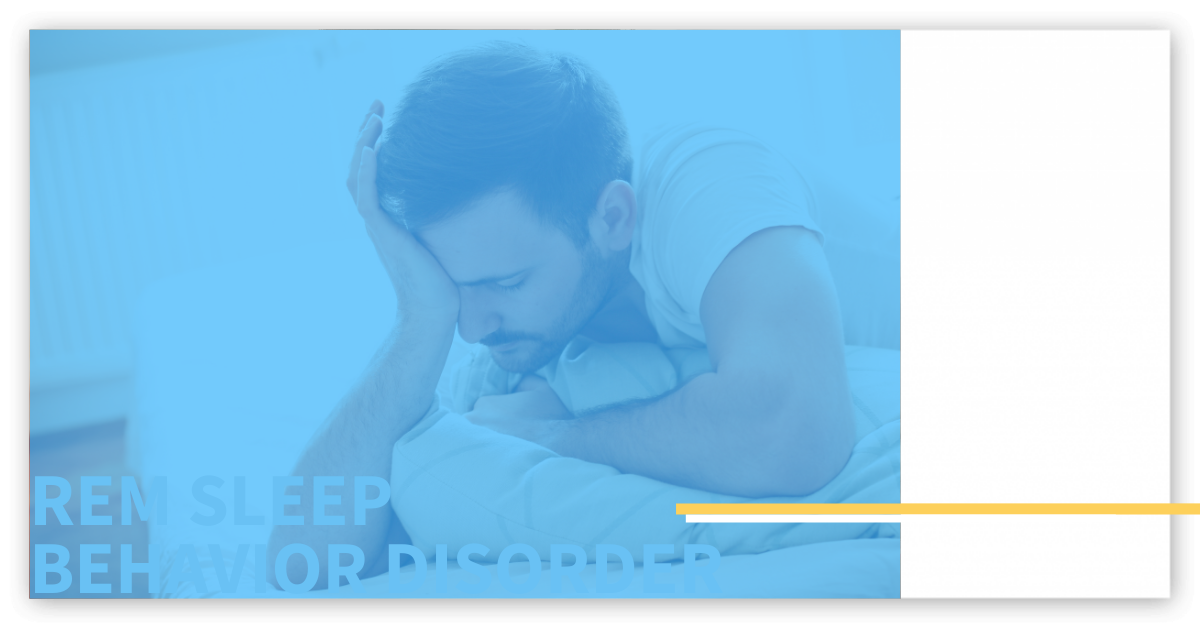What is REM Sleep Behavior Disorder?
LISTEN TO THIS ARTICLE:
Imagine you’re having an intense dream. You’re fighting with someone, throwing punches, yelling and screaming at the top of your lungs. You see an opening and run from the fight, but suddenly, something doesn’t feel right. There’s no fight. You recognize your bed room, your things are strewn everywhere, and your spouse is wide awake, wondering what happened. This is Rapid Eye Movement (REM) Sleep Behavior Disorder.
People with this disorder react verbally and physically to their dreams. Normally, our brains block muscles from moving during dreams, but that mechanism breaks down in this disorder. This leads to injuries, both for the individuals and their bed partners.
The condition can come on suddenly or gradually and occurs mostly in people over the age of 50. It’s relatively rare, appearing in less than 0.5% of the population. When it does happen, though, it can be a very early predictor of neurological conditions like Parkinson’s Disease. REM Sleep Behavior Disorder often appears in younger people who also have Narcolepsy. People who develop this sleep disturbance should be tested for these other disorders.
Causes and Risk Factors
Medications
Several classes of medications can trigger episodes of this disorder. These include tricyclic antidepressants, selective serotonin reuptake inhibitors (SSRIs), and serotonin norepinephrine reuptake inhibitors (SNRIs). Beta-blockers can be a culprit, too.
Gender and age
This disorder is largely confined to older men. The average age of people with REM Sleep Behavior Disorder is 61. Almost 90% of people with the disorder are male.
Connection to neurological issues
REM Sleep Behavior Disorder can be an early sign of neurological conditions like Parkinson’s Disease, Lewy Body Dementia, and Multiple System Atrophy (MSA). These are called “synucleinopathies,” and they all involve the accumulation of damaging synuclein proteins in the brain. At least a third of people with REM Sleep Behavior Disorder go on to develop one of those diseases many years later in life.
Co-occurring conditions
REM Sleep Behavior Disorder frequently occurs alongside a variety of other illness. This disorder appears in about 30% of people with Narcolepsy. It often comes on after someone has experienced trauma and can accompany PTSD. Strokes and alcohol intoxication/withdrawal can also trigger this disorder.
Diagnosing Rapid Eye Movement Sleep Behavior Disorder
Making the diagnosis
People with REM Sleep Behavior Disorder experience unusual behaviors during REM sleep. They will speak and move during REM sleep usually in response to dreams they are having. These are called “dream enacting behaviors.” The dreams are often action-packed or violent. People will shout, scream, kick, and punch while acting out their dreams. These are intense, emotional episodes that can endanger both the sleeper and anyone lying next to them.
When these people wake up, they are immediately aware of their surroundings and of what is going on. They can usually recall what the dream was about as well and can connect their actions to the dream’s content. All this occurs at least an hour and a half into a night’s sleep and is more common later. It does not usually occur during daytime naps.
Diagnostic tests
Multiple tests performed during sleep can be helpful in making the diagnosis. Normally during REM sleep, the body has ways of blocking muscle activation to prevent people from physically reacting to their dreams. In this disorder, that doesn’t happen. Sleep studies that monitor muscle activity during REM sleep can confirm this. This is called “REM sleep without atonia,” where “atonia” is a term for relaxed muscles. Testing positive for this is required for people to be diagnosed with Rapid Eye Movement Sleep Behavior Disorder.
Treating Rapid Eye Movement Sleep Behavior Disorder
Medications
Melatonin is the first choice treatment for this condition. It is inexpensive, available over the counter, and has few side effects. If this doesn’t reduce symptoms enough, Klonopin (clonazepam) can also help. Clonazepam, a type of benzodiazepine, relaxes muscles during sleep and prevents the physical outbursts associated with this disorder. People can combine these medications if neither is sufficient by itself.
Melatonin is a preferred option in several groups of people, including the elderly, people with dementia, and those at risk of falls. Clonazepam can cause sleepiness and balance issues upon awakening in the morning, so it should be taken with caution by vulnerable people.
Sleep hygiene
Drugs and alcohol can disrupt sleep and potentially trigger episodes of this disorder. It is worth doing a trial detox to see if avoiding certain substances can reduce symptoms. Keeping a regular sleep schedule and avoiding prolonged periods of sleep deprivation can help as well.
Managing Rapid Eye Movement Sleep Behavior Disorder
Limiting danger
While the treatment options are largely effective for most people, it is still important to plan for the worst. The key is to reduce the harm that people with this disorder can do to themselves or others. To protect bed partners, the simplest solution is to sleep in separate beds.
For the sleepers themselves, there are a variety of options. To prevent falls, you can add padded rails to the bed or place the bed against a wall. You can add padding on the floor around the bed or place the mattress directly on the floor rather than elevated on a bed frame. If people are prone to getting up and walking around in their sleep, it is safest to move the sleeping area to the ground floor of the home so they don’t fall down stairs. It’s also important to pad sharp corners or edges and remove dangerous objects from the bedroom.


 Learn
Learn Find Help
Find Help
